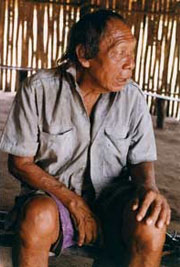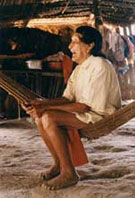Shaman's Apprentice Program
Miranda Smith: What is a shaman?
Mark Plotkin: A shaman is a medicine man or woman, but it’s much more than just a healer because it’s also a psychotherapist, it’s also a keeper of legends, it’s also a keeper of laws, even a psychopomp, the person who conveys souls to the underworld. So in a sense a shaman is one-stop shopping.
Miranda: How many real shamans have you encountered?
Mark: There’s this one fellow who was described to me as a poisoner. And every time I’d ask about healing plants or poisonous plants, he’d say, I don’t know anything about that. I don’t know a thing about healing plants, don’t know poisonous plants, don’t know anything about medicine. Well twelve years later it turns out he’s the paramount shaman. And when I ask him why he spent twelve years denying that he smiled sweetly and said, I was just pulling your leg.
He’s a trickster. The figure of the trickster is something Western minds have trouble grasping because to us a trickster is a clown, a prankster, somebody who’s not very bright, kind of the court jester. But in Native American mythology, the trickster is somebody who plays practical jokes, but he or she may also be the person who brings fire to the human species.
You can’t just walk in and say, okay, take me to your shaman. I can’t say, oh well, this trip makes 37 shamans that I’ve worked with, because there are people that I’ve worked with who have yet to reveal themselves to be shaman,and there’s people I’ve worked with who claim they’re shamans who I truly believe are not.
Miranda: When did you meet the Jaguar Shaman?
Mark: The old Jaguar Shaman was one of my first mentors down here, who was described as the greatest healer there. In December ‘82, civil war broke out in Suriname. They closed the borders of the country, no Americans, nobody could leave. The leftists were claiming the CIA was fomenting an anti-leftist coup and they were looking for American troublemakers. Well we know for a fact that was one of the few instances where the CIA was not involved, and this was just a giant political mess. It was very dangerous, it was very scary. And so I went to the local airstrip and found a pilot who was flying birds and reptiles out of Indian villages back to the capital city for eventual export. And I asked him if he could fly me to the closest Indian village to the Brazilian border. He said, if you’ve got the money, I’ll make space for you. And he flew me in. And I was greeted on the airstrip by a lot of Tiriós in red breechcloths. It was one of the happiest times of my life.
 Miranda: How did you get to study with the Jaguar Shaman?
Miranda: How did you get to study with the Jaguar Shaman?Mark: When I sat down with the chief, the chief said, why do you want to learn this stuff? He said, this is old-fashioned, we don’t use this stuff much anymore. We now have Western medicine. And I said, I heard that you almost died of malaria and he said, yes that’s true. And I said, well what did you do? He says, the missionaries gave me quinine. And I said, really? I said, do you know that quinine is an Indian medicine and was taught to the white man by native peoples to the west of here? Well nobody ever told him that.
And I knew that he was areligious man. And I said, well you know Chief, I’m not a Christian like the missionaries, I’m Jewish, Jesus is from my tribe. And I said, if my ancestors hadn’t written down Jesus’s sermons and if my ancestors hadn’t written down the Bible, you wouldn’t have these things to read in church on Sunday. I said, if we don’t work together to write down your wisdom, then your grandchildren and my grandchildren won’t be able to learn from it in the future. Well that made a pretty good impression on him and he gave me permission to work in the village and the fellow he assigned to work with me was the Jaguar Shaman. And Koita [Mark's first Tirio friend in the village] was the translator.
Miranda: What was your relationship with the Jaguar Shaman?
Mark: It was a very ambivalent relationship at the outset because on the one hand he resented the fact that I had come to learn his secrets. In fact he called me the "Pananakiri," which means "the alien." I mean that was another species as far as he was concerned.
On the other hand it was really clear to me that he really appreciated that I’d come from so far away to learn his secrets, especially in light of the fact that the kids of his tribe, his children, his grandchildren had virtually no interest in learning the old ways. So I followed him through the jungle for about three days, at which point he turned to Koita, who was a young Waiwai working with us and said, tell the Pananakiri I’ve told him all I’m going to teach him. He says, tomorrow I want to go hunting. Well that was fine with me because there were other shamans in the village with whom I wished to work. And I said that, okay, tell him that’s okay.
Well that night I was sleeping in my hut and I had this incredibly vivid, frightening dream of this enormous jaguar strolling in and fixing me with this terrible stare. I woke up with a shout, bathed in this cold sweat, and I looked around and there was nothing there. No footprints in the dirt floor, no sounds, just the sound of the wind blowing through the palm trees at the edge of the village. I finally managed to get back to sleep. The next morning Koita came to my hut and I said, before the old man goes hunting, bring him this message: last night I saw the jaguar. Mind you, no explanation. And he trotted off and came back a few minutes later. I said, did you find him? He said, yes. I said, did you tell him? He said, yes. I said, well what did he say? Koita said, the Jaguar Shaman broke into a big smile and said, "That was me."
Miranda: Do you think he was playing tricks with you?
Mark: No, I think that was a turning point in our relationship. It really broke through the barrier between the different realities we lived in and gave me a glimpse, just a glimpse into the fact that people who could turn themselves into jaguars, people who could roam the jungle at night were as real to them as lawyers and mortgages are to us. And dismissing something I couldn’t understand, dismissing something that may seem strange or weird or silly to me would have been the absolute worst thing to do. Just by accepting something I could not explain and understand through the prism of Western science I think created something of a bond and has facilitated a relationship which continues seventeen years later.
Miranda: Do you think you have more to learn from him?
Mark: Well I’ve been working with the man for seventeen years!
Let me explain it this way - a lot of ethnobotany’s been done very poorly because you take your graduate student and you drop her or him in some jungle village and say, "get a lot of data, cause I’ll be back in a year." Well three weeks, four weeks, six weeks, they’re interested, they want to help you, they want to teach you and then - they get kind of bored. So your data level tends to drop off. This isn’t always true, but I’d say by and large it often is. I think a lot of ethnobotany needs to be done in terms of long-term human relationships. There’s stuff he’ll show me now that he wouldn’t show me seventeen years ago and there’s probably stuff that he’ll show me three years from now, if I keep at it, that he wouldn’t show me five years ago. I feel that you meet these teachers, you work with them, you learn from them and they continue to teach you, and that’s the way it needs to be done.
Miranda: What happens when a shaman dies?
Mark: When a shaman dies in a pre-literate culture it’s like a library burning down. In fact it’s worse, because everything that’s in the Library of Congress is found elsewhere. There’s Gutenberg Bibles found elsewhere, not many, but they’re found elsewhere. There are transcripts of the Declaration of Independence found everywhere. So if the archives burn down, it would be a terrible loss but we still know what’s in there, we have copies of it.
 When these oral traditions are gone, they are gone forever, there’s no
bringing them back. And these oral traditions are the key to understanding,
utilizing, protecting the rain forest. These oral traditions are the key to
developing new medicines from the rain forest. So when these shamans die,
uh, the price we all pay is really quite potentially tremendous.
When these oral traditions are gone, they are gone forever, there’s no
bringing them back. And these oral traditions are the key to understanding,
utilizing, protecting the rain forest. These oral traditions are the key to
developing new medicines from the rain forest. So when these shamans die,
uh, the price we all pay is really quite potentially tremendous.
Miranda: How old are these cultures?
Mark: We believe that Amerindians are the descendants of the people who crossed the Bering Strait many years ago. There’s been some argument over how long ago that was. Some people say it’s just a few thousand years ago. Recently they have found a site in Chile, southern South America, which was 12,000 years old. If you find something that’s 12,000 years old, there’s a very great possibility, almost a certainty that it’s older and a great probability that it’s much older. I would say these cultures are probably 50,000 years old.
Back

